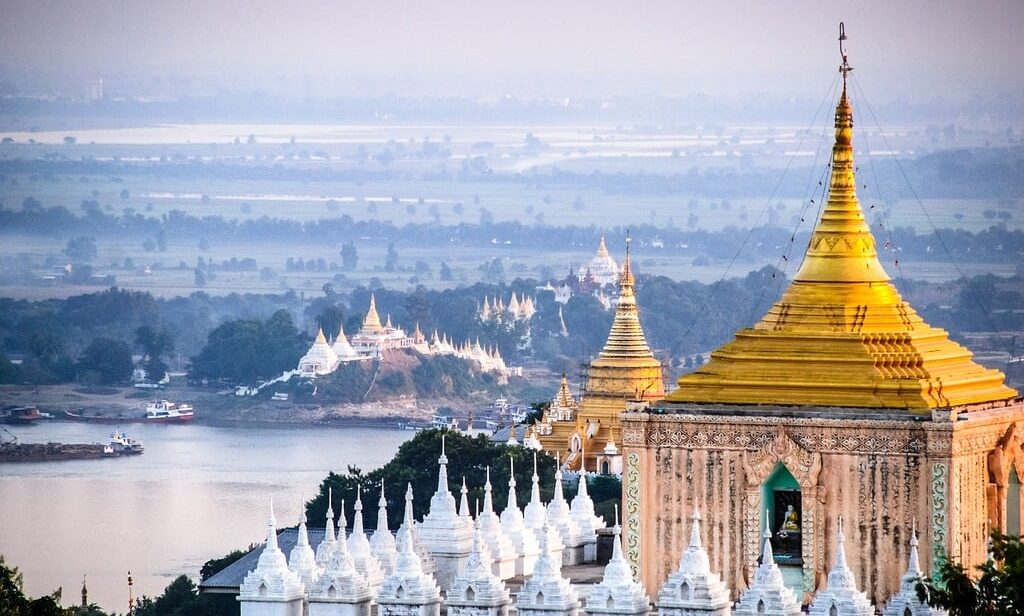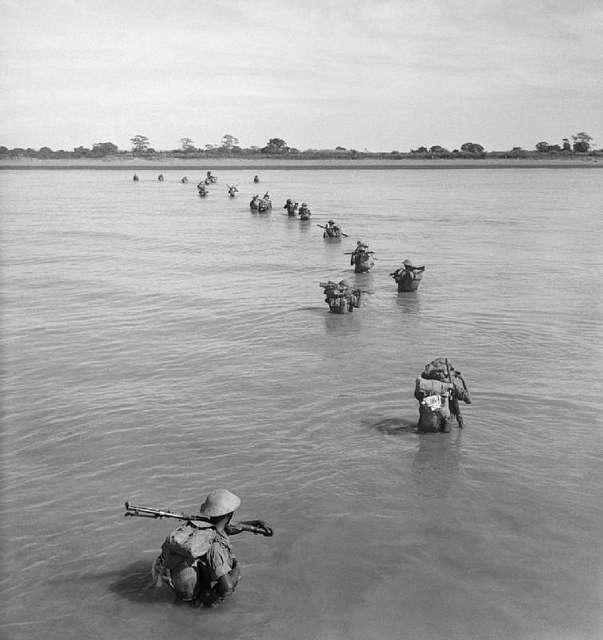
by Ophelia Yumlembam
On March 1, 2024, K. Vanlalvena, a Rajya Sabha member from the Indian state of Mizoram, met with the Arakan Army (AA) commander in the Chin State of Myanmar to raise two issues: the flow of refugees from Myanmar into Mizoram, and an unfinished road network stymieing India’s plans to build land and water connectivity with Southeast Asia. The meeting marks a potential turning point in India’s geopolitical strategy in Myanmar, as “Operation 1027” receives increasing international attention for its success in taking previously junta-controlled border regions. This military offensive, launched by the Three Brotherhood Alliance, includes the AA, the Ta’ang National Liberation Army (TNLA), and the Myanmar National Democratic Alliance Army (MNDAA). With resistance groups now claiming to control 60 percent of Myanmar’s territory, India faces an impending choice between remaining committed to the junta or strengthening its relationships with Myanmar’s ethnic armed organisations (EAOs) to protect its strategic and economic interests.
Myanmar sits at the crossroads of South Asia, Southeast Asia, and East Asia and provides access to the Indian Ocean, making the country a point of contestation between India and China. Following the 2021 coup d’état by Myanmar’s military junta, the two countries took different strategies to maintaining their influence in the country. India, to further its Act East Policy, remained committed to the junta and continued to provide economic and military support to it. China, meanwhile, has cultivated influence in Myanmar through economic, political, and military ties with both the junta and EAOs. India should similarly adapt to the instability within Myanmar. In light of the advances made by Operation 1027, India should enhance diplomatic ties with Myanmar’s EAOs to mitigate China’s influence, secure its borders, and safeguard investments, which will bolster its Act East Policy.
Understanding Myanmar’s Importance to China and India
China has long eyed Myanmar as a means to establish a strategic foothold in the Indian Ocean. Bordered by the Bay of Bengal, Myanmar offers China’s landlocked provinces like Yunnan, Guizhou, and Sichuan a vital access point to the Indian Ocean. Myanmar’s geography allows China to efficiently import resources through the country’s ports, such as precious stones, petroleum gas, rare-earth metal compounds, and more. Beijing’s efforts to advance its strategic and economic goals in Myanmar are evident in its extensive infrastructure investments as well. A strategic foothold in the Indian Ocean would not only augment China’s economic dominance, but reshape the Indian Ocean’s power dynamics, threatening India’s regional dominance and furthering China’s ambition to realize its long-term two-ocean objective.
China’s political and economic inroads into Myanmar challenge India’s regional agenda and have the potential to bring another country along India’s border into China’s sphere of influence. As various analysts point out, China’s influence in Myanmar is not only a geopolitical challenge, but also constrains India’s economic objectives. Myanmar’s geography makes it a linchpin of India’s Act East Policy, as it provides a vital land bridge for India to integrate its economy with the rest of Southeast Asia. As signaled by the spring meeting with the Arakan Army, one of India’s main strategic priorities is to develop alternative trade routes to the narrow Siliguri Corridor via ports in Kolkata and Myanmar, and connect them by road to Mizoram through the Kaladan Multimodal Transit Transport Project (KMTTP). The meeting also reflected another aspect of India’s strategic focus in its interaction with Myanmar’s divided regional authorities: border security. Historically, insurgent groups from India’s Northeast have sought refuge along the shared Indo-Myanmar border, prompting collaborative efforts between both governments since the 1990s to combat insurgent activities in the region.
China’s Strategy Towards Myanmar: Working Both Sides of the Street
Since the coup, China has adopted a strategy of engaging with both the junta and EAOs to manage its strategic influence, protect its infrastructure projects, facilitate trade, and enhance security along the Sino-Myanmar border. China openly supports the junta through diplomatic, economic, and military means, while strategically leveraging its influence in the country by presenting itself as a dependable ally committed to restoring stability and socio-economic harmony by coordinating with EAOs. This strategy is more effective in maintaining China’s border security as opposed to India’s junta-centric strategy. Also, this better positions China for success in retaining geopolitical influence as the civil war unfolds.
UN reports suggest Myanmar’s junta imported over USD $267 million in Chinese military equipment from 2022-2023, including Chinese K-8 jets, which they used to conduct air strikes targeting civilian infrastructure. Chinese state-owned investment firms have also extensively invested in infrastructure projects, including the Mee Ling Gyaing LNG terminal, Kyaukphyu Special Economic Zone (SEZ), a hydroelectric power station in Kachin state, wind power projects in Rakhine state, and a gas pipeline connecting Rakhine to Yunnan, all part of the China-Myanmar Economic Corridor under its Belt and Road Initiative (BRI). The SEZ will give Beijing access to the Bay of Bengal, offering an alternative route to the congested Strait of Malacca as U.S.-China strategic competition stirs up concerns over the strait as a maritime shipping chokepoint.
China also maintains security relations with multiple EAOs in Myanmar, notably providing weapons and political support to the United Wa State Army in Myanmar’s northeastern Shan state in exchange for their support of Chinese infrastructure projects in Myanmar. China has also collaborated with the MNDAA to address the border scam issues following the junta’s failure to tackle illegal telecom fraudsters and gambling operations along the border that have scammed thousands of Chinese nationals.
China has actively facilitated dialogue and communication among the different stakeholders in Myanmar, solidifying its position as the preeminent foreign actor amidst the country’s unrest. In January 2024, China facilitated a temporary ceasefire between the junta and the Three Brotherhood Alliance in Shan State. Though the ceasefire eventually collapsed, Beijing continued its role as a mediator by chairing the fourth round of talks between the junta and the Three Brotherhood alliance, resulting in border trade resuming after a four-month hiatus. This demonstrates China’s considerable leverage on both sides of the conflict as the civil war enters a new period of uncertainty. Following the negotiated ceasefire, the NUG committed to the One China Policy and safeguarding Chinese economic interests within Myanmar. Beijing gave no significant response to the statement, however, the statement nevertheless suggests that the NUG views China as the most relevant foreign actor, despite China’s support for the junta.

India’s Junta-Centric Strategy
New Delhi adopted a policy of comprehensive diplomatic and economic support for the junta following the 2021 coup. This includes supplying arms and dual-use and military equipment valued at up to USD $51 million, including submarines, ammunition, fuel, etc. Suppliers of these materials include state-owned entities such as Bharat Dynamics, Bharat Electronics, and Yantra India, demonstrating the Indian government’s commitment to backing the junta. India also plans to build a USD $6 billion oil refinery near Yangon to counter China’s investments. India’s support for the junta isn’t limited to financial transactions; New Delhi recently sent hundreds of junta soldiers back to junta-dominated areas after they fled into Mizoram.
India hasn’t officially engaged with EAOs for two possible reasons: first, the assumption that engaging solely with the junta is the best way to counter China’s growing influence in the country. This calculation is based on the fact that, despite setbacks following Operation 1027, the junta still holds major cities like Naypyidaw, Yangon, and Mandalay. Second, the NUG has not been strong enough to unite all armed factions, largely due to Myanmar’s complex ethnic landscape in which many EAOs seek independent control of their territories. Therefore, India appears to be adopting a wait-and-watch approach, banking that the junta’s military superiority will allow it to regain control. However, the escalating civil war in Myanmar, coupled with China’s active involvement in the country, necessitates a more nuanced Indian strategy.
Since 1990, India has cooperated with the ruling power in Naypyidaw, irrespective of its nature, to advance its economic and strategic interests. India’s persistent engagement with the junta stems from its realpolitik approach toward Myanmar, and the perception that the junta would stay in power for the foreseeable future. Even before the coup, India struggled to compete with China’s influence in Myanmar. In this context, a realistic objective for India includes strategic choices to protect its economic interests and expand the space for its influence, refusing China the opportunity to remain the only influential regional actor of significance. With significant chunks of Myanmar’s territory now under the jurisdiction of resistance groups, India needs to consider opening channels for robust engagement, especially as EAOs control the approximately 1000-mile Indo-Myanmar border. This is for three reasons:
First, China is likely to leverage its relationship with the EAOs, especially the AA, to receive permission and protection to construct the SEZ within the AA’s areas of control in the Rakhine region. Upon completion, the SEZ would provide China direct access to the Indian Ocean, securing a presence on India’s eastern flank and consolidating its maritime footprint in the Bay of Bengal. Analysts posit that this SEZ, like other Chinese facilities suspected of surveillance in Myanmar, is likely to serve a dual military and commercial purpose, requiring India to stretch its surveillance abilities to monitor China’s activities on both its eastern and western borders.
Second, India must formally engage with EAOs to advance its infrastructure projects, particularly the Kaladan Project. Completing the Kaladan Project’s road linkage between Myanmar’s Paletwa and India’s Mizoram will require negotiations with the AA, which controls Paletwa and all the townships around the Sittwe that are important to the project’s development. In 2019, the AA kidnapped five Indian workers following a joint operation by the Indian military and the junta against the AA; by delaying robust coordination with the AA, India risks the security of its project and further delays an alternative route to the strategic Siliguri corridor. While the spring meeting acknowledged the problem within Mizoram state, and the AA assured an Indian news outlet it would not harm the Kaladan project, the project’s success may ultimately hinge on the AA’s stance and points toward the immediacy for New Delhi to shift its strategy on pro-democracy groups and EAOs.
Third, New Delhi needs to collaborate with EAOs controlling the Indo-Myanmar border since India’s Northeastern insurgents have historically used the border as a launchpad for insurgent activities against the Indian Army, and are likely to capitalize on the mass displacement of civilians as the conflict escalates further. Ambushes by India’s Northeastern insurgents against the Indian army in November 2021 and November 2023 further add to the necessity. Since Operation 1027, Myanmar’s EAOs have dominated the Indo-Myanmar border and have the capability to prevent Northeastern insurgent groups from using these areas as safe havens. EAOs have incentives to cooperate with Indian security forces as the junta has reportedly used Indian insurgents against pro-democracy resistance groups.
The recent meeting between the Rajya Sabha member and the AA is a positive step, but more needs to be done at a higher level of policy-making to establish a meaningful dialogue. India should push for a Track 1.5 dialogue with the junta, the NUG, and the EAOs to find a path toward stability in Myanmar. The appeals from NUG and the EAOs for India to rethink its strategy offer an opening for India to initiate a hedging strategy. By establishing diplomatic channels with EAOs, India has the opportunity to maintain strategic leverage, border security, and protect its investments. This will not only further India’s realpolitik objectives at a potential turning point in the civil war, but also move toward support for Myanmar nationals to establish a federal democracy in Myanmar.
source : southasianvoices
